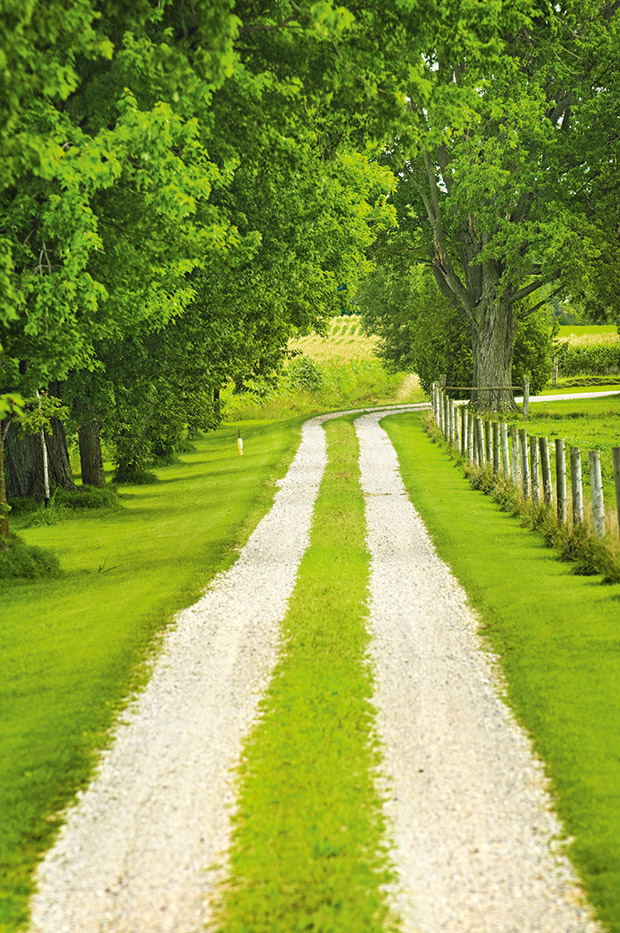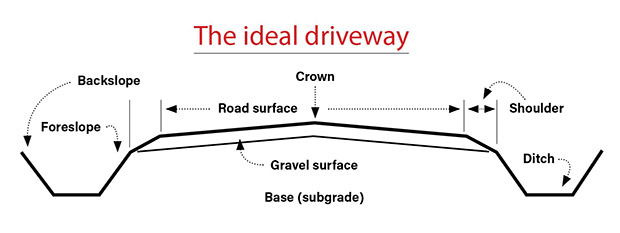How to fix potholes, corrugation and mud on your driveway

Many country driveways will worsen as they erode with use and time. Here’s how to fix the most common problems.
Words: Nadene Hall
Your dream driveway may be tree-lined with crunchy gravel, but odds are it has potholes, bone-jarring bumps, and half of it goes missing when it rains. A good quality driveway is an investment, carefully crafted to withstand heavy rain and the stresses of long-term use.
Unfortunately, many driveways are basic tracks with truckloads of gravel on top. Often they become a drain when it rains, slowly eroding and becoming more treacherous over time.
A good driveway has a few key components:
■ a firm base (known as the ‘subgrade’);
■ the correct shape with a ‘crown’, so water falls away to the sides;
■ a well-formed ‘shoulder’;
■ wide, flat-bottomed ditches on both sides;
■ a good mix of gravel, with stones, sand, and ‘fines’ (the dust that puffs up as a car drives fast over gravel).

The ideal driveway is constructed in the same way as a road. The slope should fall 4cm every metre, to a shoulder that falls away from the driving surface, into a flat-bottomed drain that is over-sized so it can cope with unusually-high rainfall.
Common problems that affect driveways include:
■ potholes and ruts;
■ patches of corrugation creating a ‘washboard’;
■ mud.
POTHOLES
The most common reason a driveway will fail is standing water. The result is potholes and ruts, which get bigger and hold more water over time.
If a driveway has areas where water sits after rain, it indicates a poor (or no) ‘crown’. The driveway surface should be shaped, so it falls smoothly from a higher mid-point to the shoulder at an ideal ratio of 4cm per metre.
Potholes form when water softens the driving surface – the mix of fines and larger gravel that sits on the surface – and then does the same to the base layer underneath. Filling in a pothole doesn’t work as water can still sit in it.
If you have areas of standing water, heavy machinery (like a tractor-mounted grader blade) will be needed to reshape the crown. If you have deep potholes, you need to grade down to the level of the deepest hole, then reform the crown.
If you only have the odd pothole, you can try a repair by hand. You need the water to be able to drain away, so use a pick or a spade to cut away at one side, to form a trench that extends all the way to the edge of the driveway. You then add base metal (to the level of the surrounding base) and compact it, and top it with a mix of gravel and fines.
CORRUGATION
This is also known as ‘washboarding’ and is common on corners and steep driveways. It’s caused by three things:
■ poor driving, eg sudden, aggressive acceleration and/or sharp braking;
■ lack of moisture in the gravel;
■ the wrong mix of gravel.
Corrugation is easiest to fix after rain has slightly softened the surface. It will require grading to restore the surface, cutting the corrugations back by about 2-3cm, then topping with a blend of fines and gravel.
To avoid corrugation forming, drive slowly and smoothly. Choose the lowest gear early so you are travelling at a constant speed as you approach a slope, one you can maintain as you climb it.
MUD
Mud coming up through the driveway’s base to the driving surface is a bad sign. It indicates serious damage to the base, possibly caused by poor drainage making it constantly wet, or a road crossing an area of naturally wet soil.
To repair it long-term may require the base and the earth below it to be dug out and replaced with specialist drainage.
Another option is to lay a geotextile over the base, then spread gravel over the top. This permeable fabric is designed to stop mud moving through into the gravel.
5 TIPS FOR A SOLID DRIVEWAY
1. Don’t grade a dry driveway. It raises dust which are fines that are important to maintaining a good driving surface. Fines act as a kind of lubrication, helping gravel to adjust under the pressure of vehicles. Ideally, grade after a light rain, when the surface is soft but not muddy.
2. Don’t remove vegetation from ditches unless it blocks the water flow, as it helps to filter water and decreases soil erosion.
3. Don’t cut down trees along the sides of a driveway if you can avoid it. Shade helps to stop the gravel from drying out, and roots help to stabilise the sides.
4. Don’t grade a driveway until you need to, to keep gravel tightly compacted.
5. Don’t drive fast. Make sure your shock absorbers are functioning properly.
CAN EMERGENCY VEHICLES GET UP YOUR DRIVEWAY?
Narrow driveways and trees planted too close to the sides, will cause access problems, especially for wide emergency vehicles such as fire engines. The driving surface needs to be at least 4m wide (preferably wider), and there needs to be at least 4m of clear space above.
Love this story? Subscribe now!
 This article first appeared in NZ Lifestyle Block Magazine.
This article first appeared in NZ Lifestyle Block Magazine.
